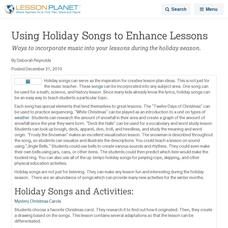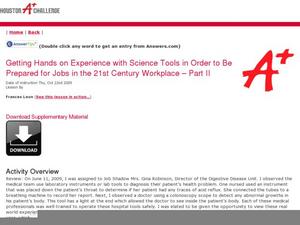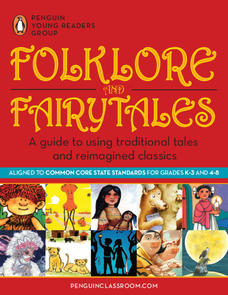Curated OER
The "Be Kind Kids" Project
Students create a visual display that highlights friendship and kindness. They read and discuss a poem, and design and create a large poster or banner that emphasizes kindness, anti-bullying, and friendship.
Curated OER
African Clothing
Students correctly identify examples of everyday clothing and special occasion clothing worn in Africa. Students will classify clothing as that used for everyday or special occasion.
Curated OER
Family Mouse Behind the Wheel
Students examine how their transportation choices affect the natural environment and their physical health as well as the power of community involvement and the dangers of over development.
Curated OER
Celebrating Groundhog Day with your Students
Celebrating Groundhog Day in your classroom is a fun-filled way to explore science, art, and literature.
Curated OER
Jobs in the 21st Century
Young scholars understand the tools that will be used in the lab in the 21st century. In this job preparation lesson, students experiment and understand how to use lab equipment. Young scholars will write about the lab tools they've...
Curated OER
Rock Around the Clock Math
An engaging and fun lesson on telling time is here for you. In it, young time-tellers listen to the song, "Rock Around the Clock," then use Judy Clocks to practice telling time to the hour and half hour. Finally, using paper plates, each...
Curated OER
Insects and Bugs
Learners recognize the difference between insects and bugs while making connections to personal experiences. In this insect and bug instructional activity, students complete a pre-assessment to demonstrate prior knowledge, then gather...
Curated OER
Graphic Organizer: Research Note Taking Made Easy
What do you wonder about bats? Use an open-ended question like this to engage your class and interest them in an upcoming research project. There's a list of example questions to offer or suggest regarding bats, but see what they can...
Curated OER
What Can I Do?
Students understand situations that cause different feelings. In this conflict resolution lesson, students read a story and complete an e-sheet about making good choices during conflict. Students to discuss the choices in the story and...
Virginia Department of Education
Weather Patterns and Seasonal Changes
Get your class outside to observe their surroundings with a lesson highlighting weather patterns and seasonal changes. First, learners take a weather walk to survey how the weather affects animals, people, plants, and trees during...
Curated OER
Get Acquainted with the Great Outdoors
National Parks and Recreation Month offers opportunities to improve health and education.
Project Articulate
Textured Landscapes with Grant Wood
Explore the world of textured landscapes through the eyes of the famous artist, Grant Wood. Here is an elementary art lesson in which scholars learn about Grant Wood's life, view his work, draw their own textured landscape, and then...
Penguin Books
Folklore and Fairytales: A Guide to Using Traditional Tales and Reimagined Classics
Every culture has its own stories to tell. An interesting educator's guide shares a large collection of fairytales and folktales, some from different cultures and some re-creations of classics. A summary and brief teaching ideas...
Curated OER
Butterfly 1: Observing the Life Cycle of a Butterfly
Students observe and identify the characteristics of the life cycle of a butterfly.
Curated OER
What You See Is What You Read
Using the popular text Franklin Goes to the Hospital, youngsters make predictions by looking at the cover of the book. They draw their predictions, listen to the story, and compare their predictions to what actually happened in the...
Curated OER
Telling Time as an Everyday Use of Numbers
How can we estimate time? Have your young mathematicians make a clock. Then they compare and contrast types of clocks. They practice writing times in two different ways and make a book about telling time.
Curated OER
A New Twist on the Keyboard
Elementary learners design and construct a diagram of a keyboard on the floor of the classroom. They outline the keyboard in masking tape by estimating size, proportion, and key position. Then they can interact with the giant keyboard as...
Curated OER
The Sum of the Parts
Second graders observe some everyday common objects in order to attempt to learn about simple systems and how they fit together. They observe small details in order to identify the parts of a whole design.
Curated OER
Making an Illustrated Dictionary with Geographic Terms
Students construct a geography dictionary. In this geography lesson, students work in small groups to construct a dictionary of geographic terms. Students use illustrations and descriptions to develop their geographic dictionaries.
Curated OER
Museums in the Classroom Pumpkin Project
Students identify the 5 stages in the life cycle of a pumpkin. They create a model showing the correct order of pumpkin life stages. They explain a pumpkin's life cycle to a partner, using their model.
Curated OER
Learning About Animal Shelters for Earth Day
Students explore habitats. in this ecology and animal habitat lesson, students listen to the book A House is a House for Me by Mary Ann Hoberman. Students discuss the basic needs of animals and go on a nature walk to observe animal...
Curated OER
Under Pressure: How Deep Can They Dive?
Students explore geography by conducting an in-class experiment. For this deep sea exploration lesson, students identify the different zones of the ocean and utilize water bottles, masking tape and scissors to conduct a water pressure...
Curated OER
Butterfly Adventure
Students in second grade are paired with fifth grade computer research buddies. They observe the characteristics of caterpillars, and identify the four stages of the caterpillar to butterfly life cycle. They graph the number of...

























